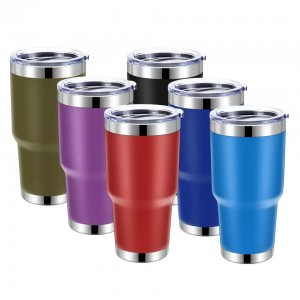- Home
- News
- Is the hot-keeping time of the stainless steel thermos water bottle the same as the cold-keeping time?
Is the hot-keeping time of the stainless steel thermos water bottle the same as the cold-keeping time?
We have popularized the common sense that stainless steel thermos cups can keep both hot and cold for a long time. However, in recent days, we have received a lot of confusion from friends at home and abroad about whether stainless steel thermos cups can keep cold. Here, let me reiterate again, the thermos cup not only protects high temperature, but also low temperature. The principle of heat preservation is completed by the double-layer vacuum structure of the water cup. The interlayer space between the stainless steel thermos cup shell and the inner tank forms a vacuum state, thus It has the function of being unable to conduct temperature, so it blocks not only heat but also cold.
On the market, the packaging of some brands of thermos cups will clearly indicate the duration of keeping hot and the duration of keeping cold. Some water cups have basically the same duration of keeping hot and cold, while others have many differences. Then some friends will ask, since they are both thermal insulation, why is there a difference between hot insulation and cold insulation? Why can’t the duration of keeping hot and keeping cold be the same?
Usually the hot-keeping time of a thermos cup is shorter than the cold-keeping time, but the opposite is also true. This is mainly caused by the difference in the heat decay time of hot water and the heat absorption increase time of cold water. It is also determined by the workmanship quality of the stainless steel water cup vacuuming process. The editor has made some attempts, but they cannot be used as scientific statistical basis. There may be some accidental factors, and there may also be some coincidences. If you have friends who have done thorough statistics and data analysis, you are welcome to give more confirmed and correct answers.
In the test done by the editor, if we set a standard value A for the vacuum in the stainless steel double-layer water cup, if the vacuum value is lower than A, the heat preservation effect will be worse than the cold preservation effect, and if the vacuum value is higher than A, the heat preservation effect will be worse than the cold preservation effect. The heat preservation effect is better than the cold preservation effect. At value A, the heat retention time and the cold retention time are basically the same.
What also affects the performance of heat preservation and cold preservation is the instant water temperature when the water is filled. Generally, the value of hot water is relatively fixed, usually at 96°C, but the difference between cold water and cold water is relatively large. Water of minus 5°C and minus 10°C is put into the thermos cup. The difference in cooling effect will also be relatively large.
